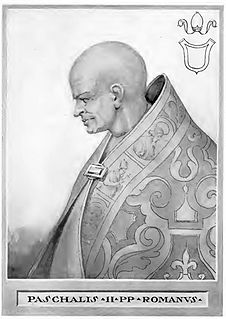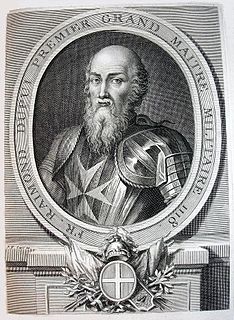
Raymond du Puy de Provence was a knight and the second superior of the Order of St. John of Jerusalem from c. 1121 until shortly before his death.

The Equestrian Order of the Holy Sepulchre of Jerusalem, also called Order of the Holy Sepulchre or Knights of the Holy Sepulchre, is a Roman Catholic order of knighthood under the protection of the Holy See. The Pope is sovereign of the Order. Founded as Milites Sancti Sepulcri attached to the Augustinian Canons Regular of the Holy Sepulchre in Jerusalem, recognised in 1113 by Papal bull of Pope Paschal II and of Pope Calistus II in 1122. It traces its roots to circa 1099 under the Frankish Duke Godfrey of Bouillon, Advocatus Sancti Sepulchri, "Defender of the Holy Sepulchre", one of the leaders of the First Crusade and first ruler of the Kingdom of Jerusalem. It is an internationally recognised order of knighthood.
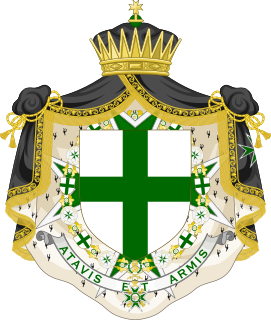
The Order of Saint Lazarus of Jerusalem, also known as the Leper Brothers of Jerusalem or simply as Lazarists, was a Catholic military order founded by crusaders around 1119 at a leper hospital in Jerusalem, Kingdom of Jerusalem, whose care became its original purpose, named after their patron saint, Lazarus. It was recognised by King Fulk of Jerusalem in 1142 and canonically recognised as hospitaller and military order of chivalry under the rule of Saint Augustine in the Papal bull Cum a Nobis Petitur of Pope Alexander IV in 1255. Although they were centered on their charism of caring for those afflicted with leprosy, the knights of the Order of Saint Lazarus notably fought in the Battle of La Forbie in 1244 and in the Defense of Acre in 1291. The titular seat was successively situated at Jerusalem, Saint-Jean-d'Acre and - after the fall of the Kingdom of Jerusalem - split in two main branches in Italy and in Château Royal de Boigny-sur-Bionne in France.

The Blessed Gerard was a lay brother in the Benedictine order who was appointed as rector of the hospice in Jerusalem in 1080, and who, in the wake of the success of the First Crusade in 1099, became the founder of the Order of St John of Jerusalem.

Manuel Pinto da Fonseca was the 67th Grand Master of the Order of Saint John, from 1741 until his death.
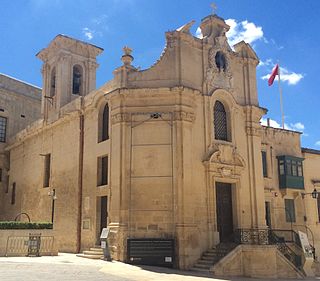
The Our Lady of Victories Church, formerly known as the Saint Anthony the Abbot Church, was the first church and building completed in Valletta, Malta. In 1566, following the Great Siege of Malta, Grand Master Jean Parisot de Valette and his Order showed interest to build a church in the name of the Nativity of the Virgin as a form of thanksgiving; the construction was funded by De Valette.
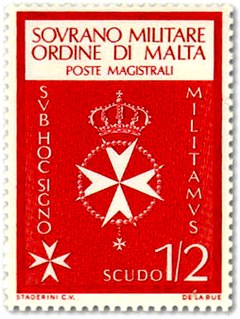
This is a survey of the postage stamps and postal history of the Sovereign Military Order of Malta.

The orders, decorations, and medals of the Holy See include titles, chivalric orders, distinctions and medals honoured by the Holy See, with the Pope as the fount of honour, for deeds and merits of their recipients to the benefit of the Holy See, the Catholic Church, or their respective communities, societies, nations and the world at large.
The following is a comprehensive list of orders, decorations, and medals bestowed by the Sovereign Military Order of Malta, both in the present-day and historically.

The flag and coat of arms of the Sovereign Military Order of Malta display a white cross on a red field, ultimately derived from the design worn by the Knights Hospitaller during the Crusades.

Saint John's Cavalier is a 16th-century cavalier in Valletta, Malta, which was built by the Order of St. John. It overlooks St. John's Bastion, a large obtuse-angled bastion forming part of the Valletta Land Front. St. John was one of nine planned cavaliers in the city, although eventually only two were built, the other one being the identical Saint James Cavalier. It was designed by the Italian military engineer Francesco Laparelli, while its construction was overseen by his Maltese assistant Girolamo Cassar.

The Church of St Mary Magdalene is a Roman Catholic church building in Valletta, Malta. The church was part of the Magdalene asylum situated adjacent to the church. The church was deconsecrated in the mid 20th century and was blessed again by Bishop Charles Scicluna on February 25, 2015.

The navy of the Order of Saint John, also known as the Maltese Navy after 1530, was the first navy of a chivalric order. It was established in the Middle Ages, around the late 12th century. The navy reached its peak in the 1680s, during the reign of Grand Master Gregorio Carafa. It was disbanded following the French invasion of Malta in 1798, and its ships were taken over by the French Navy.

The Church of Our Lady of Liesse is a church in Valletta, Malta. The church was built in 1740 on the site of a 17th-century church. The church is located near the shores of the Grand Harbour, close to Lascaris Battery and the site of the fish market. It is especially venerated by the people of the port area. There is also devotion to Our Lady of Liesse in Liesse, France.

Our Lady of Philermos is a Byzantine icon of the Theotokos, dated to the 11th or 12th century. Originally kept at Phileremos Monastery in Rhodes, the icon was long venerated as the patroness of the Knights Hospitaller, and kept at Rhodes and Malta. It is now kept in the Museum of Art and History at Cetinje, Montenegro.


